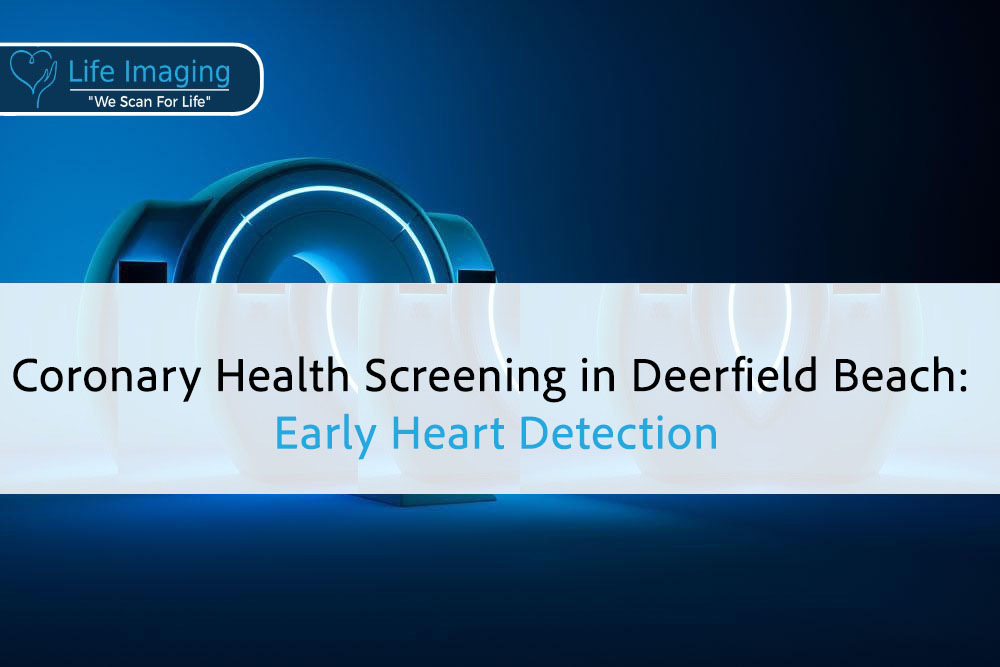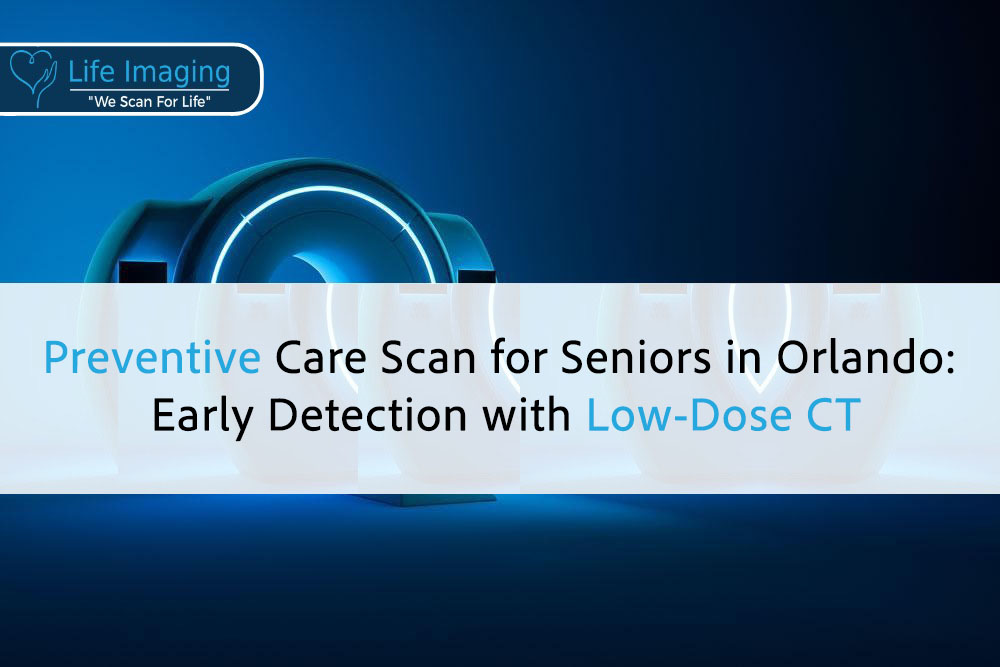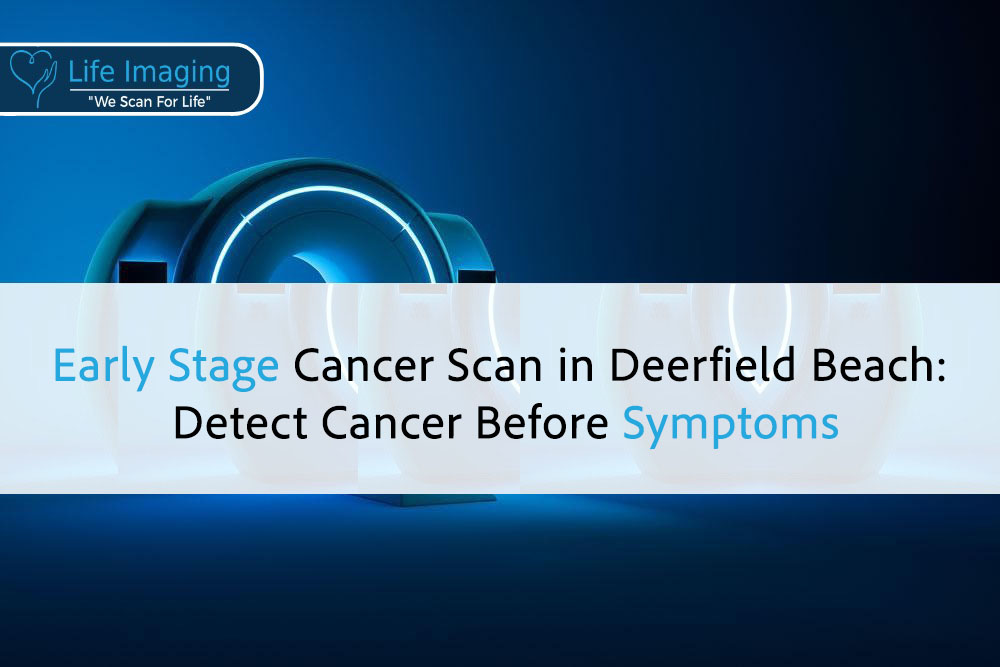
Coronary Artery Scan Near Me in Jupiter: Early Heart Health Detection
Introduction Your heart works hard every second of the day,
NOW OPEN! We’re excited to announce our new location in Jupiter, FL is now open! Learn more.

Prostate cancer is one of the most common cancers affecting men worldwide. Early detection significantly increases the chances of successful treatment and survival. However, many men are unaware of the advanced detection techniques available today that can identify prostate cancer in its early stages.
Traditional methods like PSA (Prostate-Specific Antigen) tests and DRE (Digital Rectal Exams) provide essential information but have limitations regarding accuracy and early detection. In recent years, advancements in imaging technology have revolutionized how prostate cancer is detected and managed. Technologies such as multiparametric MRI, PSMA PET scans, and advanced ultrasound techniques have become invaluable tools, providing clearer, more precise results.
Life Imaging Fla, an imaging center for the early detection of heart disease and cancer, offers state-of-the-art imaging services designed to detect prostate cancer and other severe conditions early. By utilizing the latest in imaging technology, Life Imaging Fla ensures that patients receive the most accurate and timely diagnoses, empowering them to make informed decisions about their health.
This article will explore these advanced detection techniques in-depth, discussing how they work, their benefits, and why they are crucial for early prostate cancer detection. Understanding these technologies can help individuals take proactive steps toward their health, enabling timely intervention and improved outcomes.

Multiparametric MRI (mpMRI) is a sophisticated imaging technique used to detect prostate cancer. Unlike regular MRI, mpMRI uses multiple parameters to create detailed images of the prostate.
– How It Works: mpMRI combines T2-weighted imaging, diffusion-weighted imaging, and dynamic contrast-enhanced imaging. These techniques provide different types of information about the prostate tissue.
– Benefits: mpMRI produces clear and detailed pictures of the prostate. It helps in assessing the size, shape, and location of tumors. This technique can distinguish between cancerous and non-cancerous tissues, aiding in accurate diagnosis.
Preparing for an mpMRI scan involves a few simple steps.
– Preparation: Patients may need to follow specific dietary restrictions or use an enema before the scan. These steps help improve image quality.
– During the Scan: The patient lies still inside the MRI machine while it takes images. The procedure typically lasts 30-45 minutes. Use of contrast agents can enhance image clarity.
mpMRI is highly effective in detecting prostate cancer at an early stage.
– Early Detection: mpMRI can identify tumors that traditional methods may miss. It helps in the early detection of aggressive cancers.
– Guiding Biopsies: The detailed images from mpMRI can guide targeted biopsies. This approach increases the accuracy of biopsy results.
A PSMA PET scan is an advanced imaging technique that helps locate prostate cancer cells in the body.
– How It Works: PSMA stands for Prostate-Specific Membrane Antigen. This technique uses a radioactive tracer that binds to PSMA proteins found on prostate cancer cells. A PET scan detects the tracer, highlighting cancerous areas.
– Benefits: The PSMA PET scan can detect cancer even at low levels. It provides detailed images of cancer spread, crucial for staging and treatment planning.
The PSMA PET scan process is straightforward and safe.
– Preparation: Patients are injected with a small amount of the radioactive tracer. They must wait for the tracer to circulate through the body, which can take about 1 hour.
– During the Scan: The patient lies on a table that slides into the PET scanner. The scan typically takes 20-30 minutes. The scanner detects areas where the tracer has accumulated, indicating cancerous cells.
The PSMA PET scan is highly sensitive and specific for prostate cancer detection.
– Detecting Small Tumors: This scan can identify tiny tumors that might be missed by other imaging techniques. It is excellent for detecting cancer recurrence.
– Staging Cancer: The images provide vital information about the extent of cancer spread. This helps doctors plan the appropriate treatment strategy.
Traditional ultrasound methods have limited use in prostate cancer detection, but advances in technology have improved their efficacy.
– How It Works: High-frequency ultrasound uses sound waves to create images of the prostate. These higher frequency waves provide more detailed images.
– Benefits: This method offers better resolution and image clarity than regular ultrasound. It helps identify suspicious areas within the prostate.
Micro-ultrasound is another advanced technique offering higher resolution images.
– How It Works: Micro-ultrasound uses a higher frequency of sound waves than traditional ultrasound. It produces detailed images of the prostate’s internal structure.
– Benefits: Micro-ultrasound can identify small abnormalities and guide biopsies with precision. It helps in real-time assessment of the prostate during the examination.
– Preparation: Patients may need to have a full bladder or empty bowels, depending on the specific requirements of the ultrasound technique.
– During the Scan: The patient lies down while the doctor places an ultrasound probe near the prostate. The procedure takes about 15-30 minutes and is usually pain-free.
– Real-time Imaging: Ultrasound provides real-time images, allowing immediate assessment of suspicious areas. This feature is useful during biopsies.
– Cost-Effective: Ultrasound is often less expensive compared to other imaging techniques. It can be used as a first-line imaging tool before more advanced methods.
Fusion biopsy combines traditional ultrasound imaging with multiparametric MRI (mpMRI) to improve biopsy accuracy.
– How It Works: Doctors overlay mpMRI images onto real-time ultrasound images. This technique, called image fusion, guides the biopsy needles to exact locations within the prostate.
– Benefits: Fusion biopsy provides more precise targeting of suspicious areas, reducing the chances of missing cancerous tissues. It can identify tumors that standard biopsies might miss.
The fusion biopsy involves a few detailed steps to ensure accuracy.
– Preparation: Patients may need antibiotics and an enema before the procedure. They usually undergo an mpMRI scan beforehand.
– During the Procedure: An ultrasound probe is inserted into the rectum to capture live images of the prostate. The mpMRI images guide the biopsy needles to precise locations. The procedure usually takes about 30-45 minutes.
Fusion biopsy improves diagnostic accuracy and reduces the need for repeat biopsies.
– Higher Detection Rates: This method has higher detection rates of clinically significant prostate cancer than traditional biopsy methods.
– Reducing Unnecessary Biopsies: Fusion biopsy can minimize unnecessary biopsies by accurately targeting specific areas of concern.
Genomic testing examines the DNA of prostate cancer cells to understand the genetic changes driving the disease.
– How It Works: Doctors take a sample of prostate tissue and analyze it for genetic mutations or alterations. This offers insights into the cancer’s behavior and potential aggressiveness.
– Benefits: Genomic testing provides information beyond what traditional imaging can offer. It helps predict cancer progression and tailor treatments to individual patients’ needs.
Several types of genomic tests are available for prostate cancer.
– Oncotype DX: This test analyzes the activity of certain genes to predict the aggressiveness of prostate cancer and help decide treatment options.
– Prolaris: Prolaris assesses how quickly prostate cancer cells are dividing and growing. It provides a cell cycle progression score to guide treatment decisions.
– Decipher: Decipher evaluates the risk of the cancer spreading after surgery by examining the activity of specific genes.
Genomic testing can significantly impact treatment planning and outcomes.
– Personalized Treatment Plans: By understanding the genetic profile of cancer, doctors can personalize treatment plans, improving effectiveness.
– Predicting Outcomes: Genomic tests help predict the likelihood of cancer recurrence or spread, aiding in long-term management.
Liquid biopsy is a non-invasive method of detecting cancer using a blood sample.
– How It Works: This test looks for circulating tumor cells (CTCs) or fragments of tumor DNA (ctDNA) in the blood. These markers indicate the presence of cancer.
– Benefits: Liquid biopsy is less invasive than traditional tissue biopsies and can be done frequently to monitor cancer progression and response to treatment.

The liquid biopsy procedure is simple and quick.
– Preparation: No special preparation is needed for a liquid biopsy. Patients provide a blood sample, similar to a routine blood test.
– During the Procedure: A healthcare provider draws a blood sample from the patient’s arm. The sample is then sent to a lab for analysis.
Liquid biopsy offers several advantages in managing prostate cancer.
– Monitoring Progress: This test can monitor how well the cancer is responding to treatment over time. It provides real-time insights into the tumor’s genetic changes.
– Early Detection of Recurrence: Liquid biopsy can detect cancer recurrence earlier than traditional methods, allowing for timely intervention.
MRI-TRUS fusion imaging combines Magnetic Resonance Imaging (MRI) with Transrectal Ultrasound (TRUS) for better prostate cancer detection.
– How It Works: MRI-TRUS fusion imaging overlays MRI images onto real-time TRUS images, providing a comprehensive view of the prostate.
– Benefits: This approach enhances the accuracy of prostate cancer diagnosis. It allows for better visualization of suspicious areas, aiding in targeted biopsies.
MRI-TRUS fusion imaging involves advanced imaging techniques.
– Preparation: Patients may need to undergo an MRI scan before the procedure. Specific dietary restrictions might be advised.
– During the Procedure: A TRUS probe is inserted into the rectum to capture ultrasound images. These images are fused with MRI scans to guide biopsy needles precisely to suspicious areas. The procedure takes about 30-45 minutes.
MRI-TRUS fusion imaging offers significant benefits in prostate cancer management.
– Enhanced Accuracy: Combining MRI and TRUS provides a clearer and more detailed view of the prostate. This enhances the accuracy of biopsies and detection rates.
– Reducing Overtreatment: By accurately targeting cancerous tissue, MRI-TRUS fusion can reduce unnecessary treatments and biopsies, improving patient outcomes.
The Prostate Health Index (PHI) is a blood test that helps assess the risk of prostate cancer.
– How It Works: PHI combines three different blood tests: Total PSA, Free PSA, and [-2]proPSA. These tests provide a comprehensive assessment of prostate health.
– Benefits: PHI offers more accurate risk assessment than PSA alone. It helps differentiate between benign prostate conditions and prostate cancer.
The PHI test is simple and non-invasive.
– Preparation: No special preparation is needed for the PHI test. Patients need to provide a blood sample.
– During the Procedure: A healthcare provider draws a blood sample from the patient’s arm. The sample is then analyzed for the three PSA components.
The PHI test enhances prostate cancer screening and risk assessment.
– Improved Risk Stratification: PHI provides a more accurate assessment of prostate cancer risk, helping doctors make better-informed decisions about further testing or treatment.
– Reducing Unnecessary Biopsies: By offering a more precise risk evaluation, PHI can reduce the need for unnecessary biopsies and associated risks.
By using these cutting-edge techniques, healthcare providers can improve the early detection and accurate diagnosis of prostate cancer. Advanced methods like fusion biopsy, genomic testing, liquid biopsy, MRI-TRUS fusion imaging, and the Prostate Health Index offer precise and detailed insights essential for effective treatment planning and better patient outcomes.
Regular screenings and proactive monitoring using these advanced techniques can lead to early intervention, ultimately saving lives. Understanding the importance and benefits of these technologies is vital for anyone at risk of prostate cancer, as early detection remains key to successful treatment and recovery.
The PCA3 test is a specific genetic test for detecting prostate cancer.
– How It Works: PCA3 stands for Prostate Cancer Antigen 3. The test measures the amount of PCA3 RNA in a urine sample. This RNA is produced only by prostate cancer cells, making it a valuable marker.
– Benefits: The PCA3 test is more specific to prostate cancer compared to the PSA test. It reduces false positives and offers better insight into whether a biopsy is needed.
The PCA3 test involves simple steps and is non-invasive.
– Preparation: Before the test, a digital rectal exam (DRE) is often performed to release prostate cells into the urine. Afterward, a urine sample is collected.
– During the Procedure: The urine sample is analyzed in a lab to measure the levels of PCA3 RNA. The result, known as the PCA3 score, indicates the likelihood of prostate cancer.
The PCA3 test helps in making biopsy decisions and assessing prostate cancer risk.
– Reducing Unnecessary Biopsies: A high PCA3 score suggests a higher risk of prostate cancer, potentially justifying a biopsy. A low score may help avoid unnecessary biopsies.
– Complementing PSA Tests: When used alongside PSA tests, the PCA3 test provides a clearer picture of prostate health, improving diagnostic accuracy.
A Digital Rectal Exam (DRE) is a manual test performed by a healthcare provider to check for abnormalities in the prostate.
– How It Works: During a DRE, a doctor inserts a lubricated, gloved finger into the rectum to feel the prostate gland. They check for lumps, irregularities, or hard areas that might indicate cancer.
– Benefits: DREs are quick and can be performed during routine physical exams. They help detect changes in the prostate that might require further testing.
The DRE is a simple and straightforward examination.
– Preparation: No special preparation is required for a DRE. Patients should inform their doctor of any symptoms or concerns before the exam.
– During the Procedure: The patient may stand and bend forward or lie on their side with knees pulled up. The doctor gently inserts a finger into the rectum to check the prostate. The exam usually takes only a few minutes.
While DREs are simple, they remain valuable as an initial screening tool.
– Initial Screening: A DRE can identify abnormalities that warrant further investigation, such as lumps or hard areas.
– Combined with PSA Tests: When combined with PSA tests, DREs provide a more comprehensive assessment of prostate health, guiding decisions about additional testing.
Transrectal Ultrasound (TRUS) is an imaging technique used to examine the prostate and guide biopsies.
– How It Works: TRUS uses sound waves to create detailed images of the prostate. A small probe inserted into the rectum emits these sound waves, which bounce off the prostate and create an image on a screen.
– Benefits: TRUS provides real-time images, helping doctors assess the prostate’s size and structure. It is also valuable for guiding biopsy needles to precise locations.
The TRUS procedure is relatively quick and non-invasive.
– Preparation: Patients may need an enema before the procedure to clear the rectum. Some may also receive antibiotics to prevent infection.
– During the Procedure: The patient lies on their side while the doctor inserts the ultrasound probe into the rectum. The probe captures images of the prostate, and if needed, guides the biopsy needles to specific areas. The procedure typically lasts 15-30 minutes.
TRUS is effective in guiding biopsies and assessing prostate abnormalities.
– Guiding Biopsies: The real-time images from TRUS help doctors target specific areas for biopsy, increasing accuracy and detection rates.
– Evaluating Prostate Size: TRUS helps measure the prostate’s size and detect any irregularities, aiding in the diagnosis and management of prostate conditions.
MRI-guided biopsy is an advanced technique that uses MRI imaging to guide prostate biopsies.
– How It Works: MRI scans provide detailed images of the prostate, showing suspicious areas. These images guide the biopsy needles to the most concerning regions, ensuring accurate sampling.
– Benefits: MRI-guided biopsy increases the likelihood of detecting significant prostate cancer. It reduces the chances of missing tumors, providing more reliable results.
The MRI-guided biopsy involves precise imaging and careful execution.
– Preparation: Patients may need to follow dietary restrictions and take an enema before the procedure. An MRI scan is performed beforehand to map out the prostate.
– During the Procedure: The patient lies on an MRI table while the MRI images guide the biopsy needles to exact locations within the prostate. The procedure typically lasts 45-60 minutes and is usually performed under local anesthesia.
MRI-guided biopsy offers unparalleled accuracy in prostate cancer detection.
– Higher Detection Rates: This technique significantly improves the detection of clinically significant prostate cancer, reducing the risk of false negatives.
– Minimizing Unnecessary Biopsies: By targeting specific areas, MRI-guided biopsy minimizes the need for multiple biopsies and associated risks.
Contrast-Enhanced Ultrasound (CEUS) uses contrast agents to improve the clarity and detail of ultrasound images.
– How It Works: A contrast agent injected into the bloodstream highlights blood flow in the prostate. This helps differentiate between benign and malignant tissues, as cancerous areas often have different blood flow patterns.
– Benefits: CEUS provides clear and detailed images, improving the detection of prostate abnormalities. It is minimally invasive and can be used repeatedly without significant risks.
The CEUS procedure is simple and enhances traditional ultrasound imaging.
– Preparation: Patients may need to follow specific instructions regarding food and drink before the procedure. The contrast agent is prepared for injection.
– During the Procedure: The patient lies on an examination table while the contrast agent is injected into a vein. An ultrasound probe is used to capture images of the prostate as the contrast agent travels through the bloodstream. The procedure usually takes about 30 minutes.
CEUS enhances the diagnostic capability of ultrasound imaging.
– Improved Detection: The contrast agent highlights blood flow patterns, helping identify cancerous areas more accurately.
– Complementing Other Tests: When used alongside other imaging techniques, CEUS provides a comprehensive assessment, aiding in accurate diagnosis and treatment planning.
By utilizing cutting-edge techniques like multiparametric MRI, PSMA PET scans, advanced ultrasound methods, fusion biopsy, genomic testing, liquid biopsy, MRI-TRUS fusion imaging, Prostate Health Index, the PCA3 test, DRE, TRUS, MRI-guided biopsy, and contrast-enhanced ultrasound, healthcare providers can significantly improve the early detection and accurate diagnosis of prostate cancer. These advanced methods offer a detailed and precise understanding of prostate health, allowing for more personalized treatment plans and better patient outcomes.
Early detection remains crucial in the fight against prostate cancer, as it significantly increases the chances of successful treatment and recovery. Advanced imaging and diagnostic techniques reduce unnecessary biopsies, minimize invasive procedures, and provide real-time monitoring of cancer progression. Understanding these options empowers patients and healthcare providers to make informed decisions, leading to timely intervention and improved quality of life.
At Life Imaging Fla, we are committed to leveraging the latest advancements in prostate cancer detection to provide the best care for our patients. Our state-of-the-art facilities and expert team are dedicated to using these technologies to catch prostate cancer early and accurately, ensuring our patients receive the most effective treatment possible.
Take control of your prostate health today. Schedule a screening with Life Imaging Fla and experience the benefits of advanced prostate cancer detection techniques. Early detection can save lives—don’t wait until it’s too late. Contact us now and prioritize your health with the best in diagnostic imaging.

Introduction Your heart works hard every second of the day,

Introduction Your heart works around the clock, but changes inside

Introduction Your heart works nonstop, often without a single complaint.

Introduction The best part of getting older is having time

Introduction Good health isn’t just about treating problems, it’s about

Introduction Cancer often begins quietly, long before you feel anything

* Get your free heart scan by confirming a few minimum requirements.
Our team will verify that you qualify before your scan is booked.
Copyright © 2025 Life Imaging – All Rights Reserved